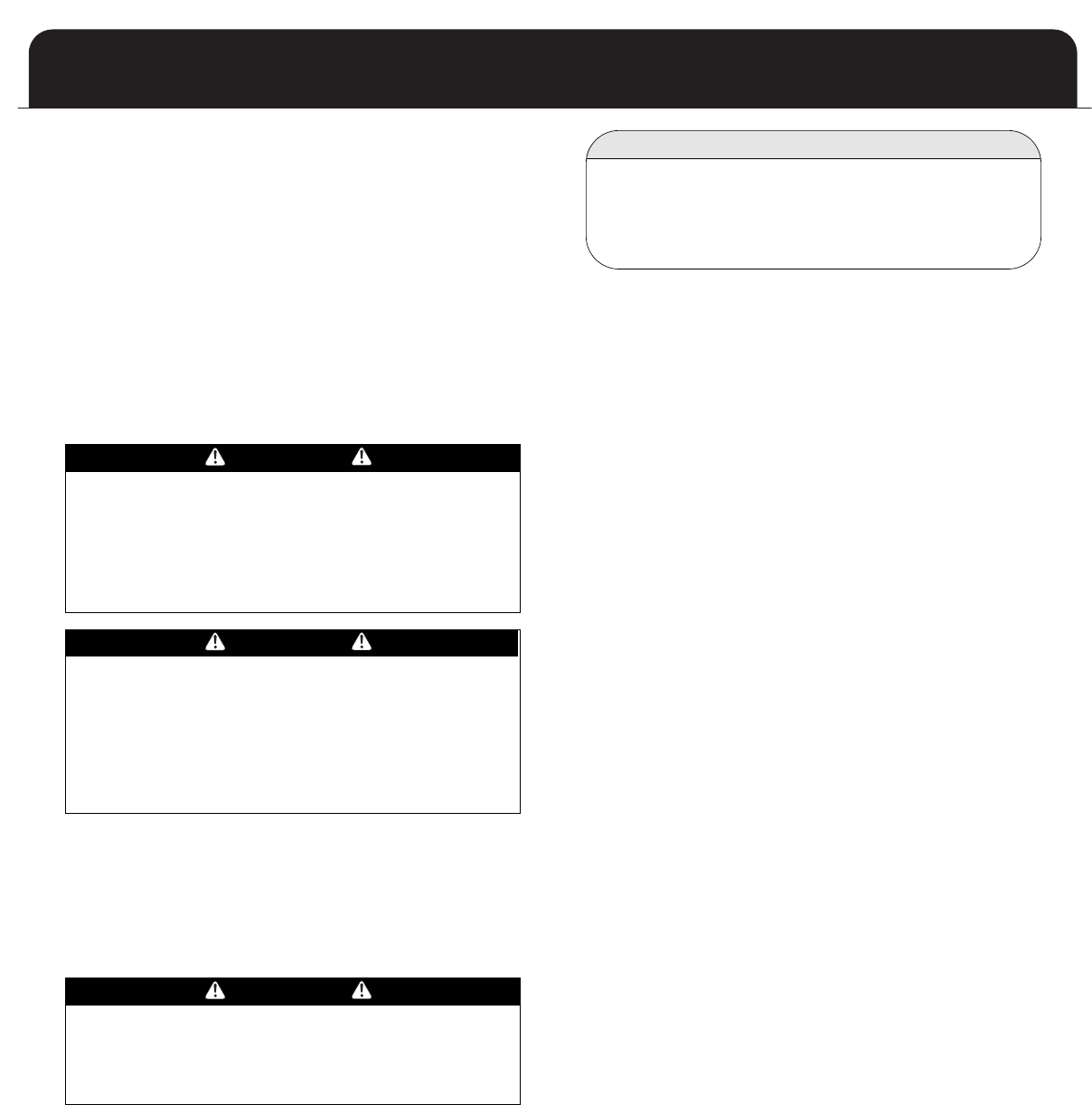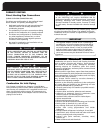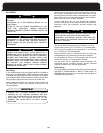
DANGER
SOLVENT CEMENTS AND PRIMERS ARE HIGHLY
FLAMMABLE. PROVIDE ADEQUATE VENTILATION AND DO
NOT ASSEMBLE NEAR HEAT SOURCE OR OPEN FLAME. DO
NOT SMOKE. AVOID SKIN OR EYE CONTACT. OBSERVE ALL
CAUTIONS AND WARNINGS PRINTED ON MATERIAL
CONTAINERS. FAILURE TO FOLLOW THESE GUIDELINES
MAY RESULT IN FIRE, EXPLOSION OR AS-PHYXIATION
CAUSING PERSONAL INJURY OR LOSS OF LIFE.
WARNING
THIS FURNACE AND ANY OTHER FUEL BURNING
APPLIANCE MUST BE PROVIDED WITH ENOUGH FRESH
AIR FOR PROPER COMBUSTION AND VENTILATION OF
THE FLUE GASES. MOST HOMES WILL REQUIRE THAT
OUTSIDE AIR BE BROUGHT TO THE FURNACE AREA.
FAILURE TO DO SO CAN CAUSE PERSONAL INJURY, OR
DEATH FROM CARBON MONOXIDE POISONING.
NON-DIRECT VENT FURNACE
INSTALLATIONS
(USING INDOOR COMBUSTION AIR)
The furnace, although designed as a direct vent type
appliance, may be installed with the intake vent inside
the structure. Non-direct vent installations require only an
exhaust vent pipe.
N
on-direct venting may be desirable when:
• Using outdoor combustion air is not practical
• The furnace is in a garage or attic
• Provisions are not made for routing of combustion air
• The outdoor environment may contain contaminants
undesirable for combustion
Connecting a Non-Direct Vent to the Furnace
When using indoor air or the non-direct vent
configuration, the combustion air inlet to the furnace must
be protected from blockage. Use a double elbow
arrangement if supplying combustion air through the top,
or a downward pointing single elbow if supplying
combustion air through the side.
WARNING
READ AND FOLLOW ALL INSTRUCTIONS IN THIS SEC-
TION. FAILURE TO PROPERLY VENT THIS FURNACE CAN
CAUSE CARBON MONOXIDE POISONING OR AN EXPLO-
SION OR FIRE RESUL
TING IN PROPERTY DAMAGE, PER-
SONAL INJURY OR LOSS OF LIFE.
I
f the furnace is to be installed in the vicinity of other
fuel burning appliances, adequate combustion air
must be available for the non-direct vent appliances.
See Section 10 of this manual, “Determining
Combustion Air.”
IMPORTANT
IN CANADA
In addition to the general guidelines, in Canada, the non-
direct vent exhaust shall not terminate:
• Directly above a paved sidewalk or paved driveway
which is located between two single-family dwellings
and serves both dwellings;
• Less than 7 feet above a paved sidewalk or paved
driveway located on public property;
• Within 6 feet of a mechanical air supply inlet to any
building;
•
Above a meter/regulator assembly within 3 feet
horizontally of the centerline of the regulator;
• Within 6 feet of any service regulator vent outlet;
• Less than 12” above grade level or anticipated snow
level;
• Within 12” of any door, window, or non-mechanical air
supply inlet to any building;
•
Within 12” of the combustion air inlet of any other
appliance;
• Underneath a veranda, porch or deck, unless (a) the
veranda, porch or deck is fully open on a minimum of
two sides beneath the floor, and (b) the distance
between the top of the vent termination and the
underside of the veranda, porch or deck is greater
than 12”.
IN THE U.S.A.
In addition to the general guidelines, in the United States,
the non-direct vent exhaust shall be installed in accordance
with the following:
• The clearance from the bottom of the terminal to grade
shall be 12” or increased to maintain 12” above the antici-
pated accumulated snow level.
• The vent shall not terminate over public walkways or
over an area where condensate or vapor could create a
nuisance or hazard.
• The vent terminal shall be installed 4 feet below, 4 feet
horizontally from, or 1 foot above any door, window, sof-
fit, under eave vent or gravity air inlet to the building.
• The vent terminal shall have a minimum horizontal clear-
ance of 4 feet from electric meters, gas meters, regulators
and relief equipment.
• Locate the vent terminal 3 feet above any forced air inlet
located within 10 feet. Any fresh air or make-up air inlet,
such as for a dryer or furnace area is considered a forced
air inlet. The vent terminal should be located no fewer
than 6 feet from an inside corner formed by two exterior
walls; a 10 foot distance is recommended.
Recommended clearance from overhangs is a minimum of
1 foot vertically for each foot horizontally up to 6 feet.
22


















